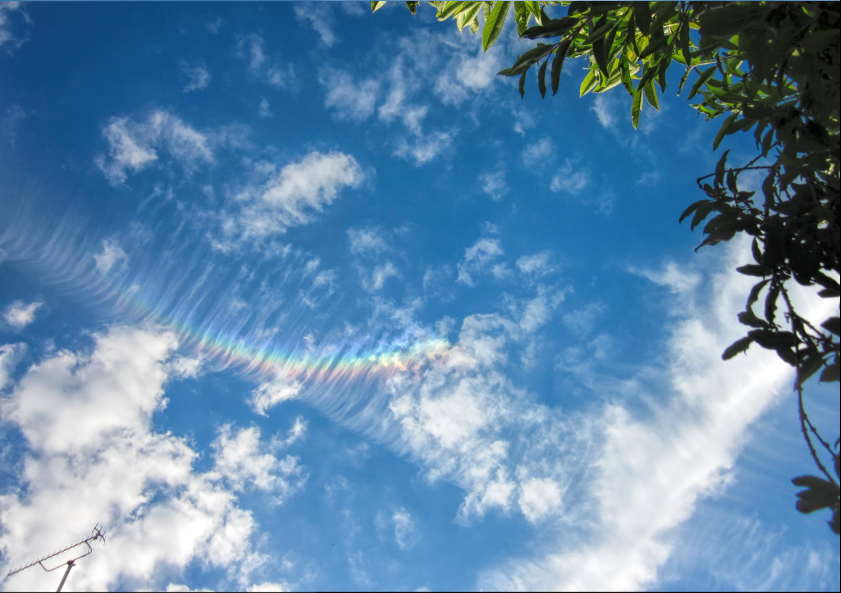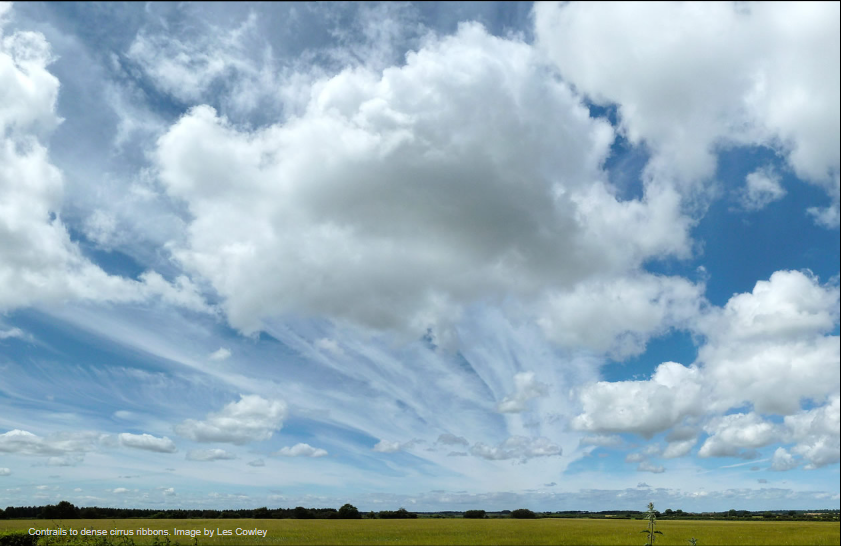Circumzenithal Arc, UK - OPOD
Circumzenithal Arc: A Spectacular Atmospheric Phenomenon
Have you ever looked up at the sky and been amazed by the beauty and complexity of atmospheric optics? One such phenomenon that can leave you in awe is the Circumzenithal Arc (CZA). This stunning display of colors can be seen in the sky, particularly in regions with clear blue skies and the right atmospheric conditions. In this article, we will delve deeper into the science behind the Circumzenithal Arc and explore its mesmerizing features.
The Chilterns, England: A Perfect Setting for the CZA
On the 25th of June in 2014, Jane Moore-Taylor captured a breathtaking image of the Circumzenithal Arc from the Chilterns, England. The skies were painted in a clear blue hue, with minimal extinction near the horizon. The presence of low cumulus fractus clouds added contrast to the blue backdrop. Additionally, the humidity levels were just right to allow contrails to spread and form long-lasting cirrus ribbons. Although a circumhorizon arc was not visible during the narrow time slot around noon near the solstice, the equally captivating circumzenithal arc compensated for it.
Unveiling the Science Behind the Circumzenithal Arc
To truly appreciate the Circumzenithal Arc, we need to understand its scientific origins. This phenomenon occurs when almost parallel rays of sunlight enter the top face of a hexagonal plate crystal suspended in the atmosphere. These rays undergo refraction as they pass through the ice crystal, exiting through one of its side faces. This path is akin to the passage of light through a 90° prism in a spectrometer, resulting in the production of nearly pure spectral colors.
Exploring the Inner Workings of the CZA
Let's take a closer look at the internal structure of the Circumzenithal Arc. When the sun's elevation surpasses 32°, the rays of sunlight from the roof of the ice crystal strike the wall at a shallow angle. Consequently, these rays are no longer transmitted through the wall. Instead, the wall acts as a perfect mirror, undergoing total internal reflection. This change in angle leads to the disappearance of the Circumzenithal Arc.
The Magnificent Visual Display
The images captured by Jane Moore-Taylor vividly depict the beauty of the Circumzenithal Arc. The arc appears as an upside-down rainbow positioned directly overhead, with its colors arranged in a similar order to those of a conventional rainbow. However, unlike a rainbow, the Circumzenithal Arc is often more vibrant and intense, thanks to its formation through the refraction of sunlight in ice crystals.
Chasing the Circumzenithal Arc
Witnessing a Circumzenithal Arc is a truly remarkable experience. However, it is not a common occurrence and requires specific atmospheric conditions to manifest. Here are some key factors that contribute to the formation of this stunning optical phenomenon:
- A northern air stream that renders the skies clear and blue with minimal extinction near the horizon.
- Low cumulus fractus clouds that provide contrast to the blue sky.
- Optimal humidity levels that allow contrails to spread and form cirrus ribbons.
- Sunlight with an elevation above 32°, enabling the necessary refraction and reflection within ice crystals.
Conclusion
The Circumzenithal Arc is a captivating atmospheric optics phenomenon that can leave spectators spellbound. Its formation through the refraction and reflection of sunlight in ice crystals creates a vibrant display of colors in the sky. While not as commonly observed as a rainbow, the Circumzenithal Arc rewards those fortunate enough to witness it with a truly extraordinary experience. So, keep your eyes to the sky and embrace the wonders that the atmosphere has to offer.

Circumzenithal Arc
A capture by Jane Moore-Taylor from the Chilterns, England on 25th June ’14.
Over the past few days a northern air stream has rendered English skies the clearest blue with little extinction near to the horizon, a blue deepened by contrast with low cumulus fractus Humidity has been just right to spread contrails into wide long-lasting cirrus ribbons that as the day progressed thickened and spread more. This cirrus has so far failed to show a much sought circumhorizon arc in the narrow time slot available around noon near the solstice. However, an equally pure coloured circumzenithal arc is here an ample compensation.
All images ©Jane Moore-Taylor, shown with permission

Almost parallel sun rays enter the top face of a hexagonal plate crystal. They are refracted and pass through the ice to leave through a side face. The path is equivalent to passage through a 90° prism in a spectrometer and gives nearly pure spectral colours
Inside view:
Rays enter the roof and leave through the right wall. The wall reflects some rays and these leave through the floor to help light the parhelic circle.
When the sun climbs higher than 32° the rays from the roof strike the wall at too shallow an angle to be transmitted. To them, the wall closes and becomes a perfect mirror (total internal reflection). There is no longer any CZA.


Note: this article has been automatically converted from the old site and may not appear as intended. You can find the original article here.
Reference Atmospheric Optics
If you use any of the definitions, information, or data presented on Atmospheric Optics, please copy the link or reference below to properly credit us as the reference source. Thank you!
-
<a href="https://atoptics.co.uk/blog/circumzenithal-arc-uk-opod/">Circumzenithal Arc, UK - OPOD</a>
-
"Circumzenithal Arc, UK - OPOD". Atmospheric Optics. Accessed on November 23, 2024. https://atoptics.co.uk/blog/circumzenithal-arc-uk-opod/.
-
"Circumzenithal Arc, UK - OPOD". Atmospheric Optics, https://atoptics.co.uk/blog/circumzenithal-arc-uk-opod/. Accessed 23 November, 2024
-
Circumzenithal Arc, UK - OPOD. Atmospheric Optics. Retrieved from https://atoptics.co.uk/blog/circumzenithal-arc-uk-opod/.